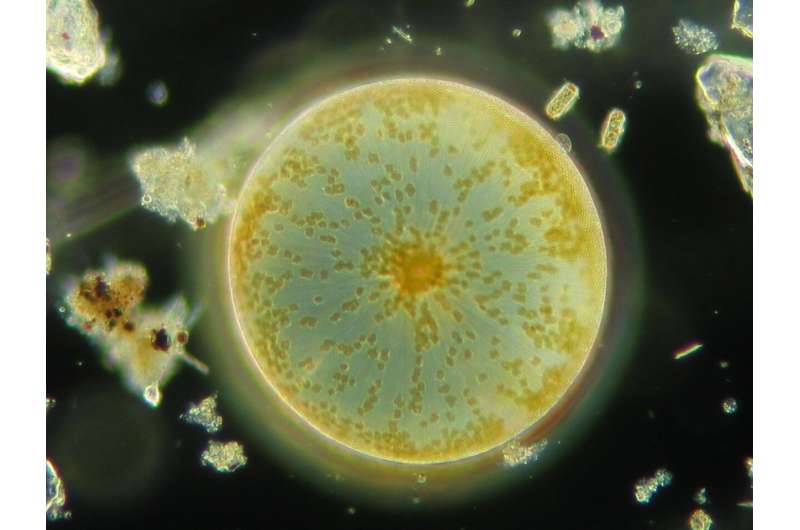This article has been reviewed according to Science X's editorial process and policies. Editors have highlighted the following attributes while ensuring the content's credibility:
fact-checked
peer-reviewed publication
trusted source
proofread
What phytoplankton physiology has to do with global climate

Phytoplankton, tiny photosynthetic organisms in the ocean, play a crucial role in the global carbon cycle and influence Earth's climate. A new study reveals how variations in the physiology of phytoplankton, particularly regarding nutrient uptake, can impact the chemical composition of the ocean and even the atmosphere. This suggests that changes in marine phytoplankton physiology can affect global climate.
Phytoplankton in the ocean are central to the global carbon cycle as they perform photosynthesis, capturing and transporting carbon (C) to the deep ocean. The growth of phytoplankton relies not only on carbon but also on nitrogen (N) and phosphorus (P), which are crucial for their cellular functioning.
Phytoplankton stoichiometry defines the relative proportions of different elements such as C, N, and P in these organisms. Key connections exist between phytoplankton stoichiometry and climate through interdependencies between the oceanic carbon pump, nutrient cycling, food web dynamics, and responses to climate-related factors like atmospheric carbon dioxide (CO2) concentration and temperature.
In the 1930s, the American oceanographer Alfred C. Redfield made an important discovery: he found that the concentrations of the elements C, N, and P in the marine phytoplankton roughly follow a fixed ratio of approximately 106:16:1—the ratio now named after him, the Redfield ratio.
Surprisingly, Redfield's research also revealed that in the seawater samples he collected, the concentration of nitrate, a primary nitrogen nutrient source, was, on average, 16 times higher than the concentration of phosphate, a primary phosphorus nutrient source. The nitrogen-to-phosphorus (N:P) ratios in both phytoplankton and seawater are remarkably similar, indicating a strong connection between the particulate (phytoplankton) and dissolved (seawater) nutrient pools.
The question of whether the N:P ratio of the dissolved pool controls the ratio in particulate material, or vice versa, has long puzzled the marine science community. "It's a chicken-and-egg question," says Dr. Chia-Te Chien, a researcher in the Biogeochemical Modeling Research Unit at the GEOMAR Helmholtz Center for Ocean Research in Kiel, who is investigating the role of variable stoichiometry of phytoplankton in the marine biogeochemistry.
Together with his colleagues, he has now carried out a modeling study that examines the relationship between the ratios of nitrogen and phosphorus in dissolved inorganic and particulate organic matter in seawater. The study, now published in the journal Science Advances, emphasizes the importance of variable C:N:P ratios of phytoplankton for regulating dissolved oceanic nutrient ratios on a global scale and highlights marine oxygen levels as a critical regulator in the Earth system.
To investigate these relationships, the authors used a computer model of algal physiology coupled to an Earth system model, wherein phytoplankton dynamically optimize their C:N:P ratios in response to varying environmental conditions. In the computer model, they could alter the characteristics of phytoplankton and observe how this changed the nitrogen and phosphorus ratios in the water.
They carried out an ensemble of 400 simulations, which differ in the minimal nitrogen and phosphorus contents required by algae to stay alive. The model results reveal intricate feedback mechanisms involving changes in the nitrogen and phosphorus content of phytoplankton, oceanic oxygen levels, N2 fixation by nitrogen-fixing phytoplankton, and denitrification.
These model results challenge the commonly hypothesized strong link between phytoplankton and seawater nutrient ratios. Rather than attempting to uncover the reasons behind the resemblance in the currently observed ratios between phytoplankton and seawater, the results highlight that these ratios are not inherently similar. In other words, the similarity, as it is observed these days, is a specific state, and this state may be subject to change, at least on a time scale that is not covered by the many decades of ocean in situ observations.
Additionally, the analysis highlights the potentially substantial influence of phytoplankton subsistence nitrogen and phosphorus quotas on atmospheric CO2 levels on geological time scales. Traditionally, stoichiometric variations of the phytoplankton and within the marine ecosystem were considered to have a relatively minor impact on marine biogeochemistry and, consequently, atmospheric CO2 levels. This view could now be questioned, because this study points to the potential importance of a physiological detail for climate conditions on our planet.
The authors explain the significance of the findings, "Our results demonstrate that the concentration of atmospheric CO2 as well as the ocean and air temperature are remarkably sensitive to variations in elemental stoichiometry induced by changes in phytoplankton physiology." Understanding these connections could help scientists make more accurate predictions about how our planet's ecosystems and climate will evolve in the future.
More information: Chia-Te Chien et al, Effects of phytoplankton physiology on global ocean biogeochemistry and climate, Science Advances (2023). DOI: 10.1126/sciadv.adg1725
Journal information: Science Advances
Provided by Helmholtz Association of German Research Centres




















